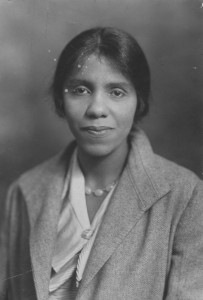Juliette Derricotte: Remembering Healthcare Denied
August 27, 2010
As told by Langston Hughes in November 1931 Juliette Derricotte was driving with three of her students from Fisk University in Nashville to her parent’s home in Georgia. Suddenly an approaching car, in order to pass a slower vehicle swerved toward the center of the road. Miss Derricotte, to avoid a collision, turned quickly to the side of the highway. Her wheels sank into a ditch, and her car turned over. The three students accompanying the Dean of Women were all badly injured. Passing motorists carried them into the nearest town, a small southern farming center. Here the white hospital refused point blank to give treatment to African-Americans, so the bruised and bleeding victims were not admitted. Instead they we taken to the house of a poor black woman of the town and there white doctors gave them attention, but without the necessary instruments and anesthetics that the hospital could have furnished.
Three of them were suffering intensely, but the least injured of the four, a young student was able to find a telephone. He called the nearest city in which a Negro hospital was located, and asked that an ambulance be sent for them. Late in the night the ambulance arrived, but on the way to the distant Negro hospital Juliette Derricotte died. A brilliant woman with much to offer was lost to America. Had not a white hospital refused to treat black people—even in so grave an emergency as this serious automobile accident—her life might have been saved.
Derricotte is most remembered today for her death and the national outrage it caused leading to a series of investigations; the NAACP became involved; the Commission of Interracial Co-operation of Atlanta made an investigation at the request of Fisk University and other organizations. Early in her career she worked with the YWCA traveling the globe studying in England and immersing herself in foreign cultures of India, Sri Lanka, and Burma. Through these experiences she was touched and transformed returning to Fisk University bringing her sense of global humanity and desire for a more just and human society.
Disparities persist in African-American health care while no longer a matter of overt discrimination the negative entrenched impact lingers. The burden of death and living remains far greater for people of color. In the United States, health disparities are well documented in minority populations such as African Americans, Native Americans, Asian Americans, and Latinos. When compared to whites, these minority groups have higher incidence of chronic diseases, higher mortality, and poorer health outcomes. Among the disease-specific examples of racial and ethnic disparities in the United States is the cancer incidence rate among African Americans, which is 10% higher than among whites. In addition, adult African Americans and Latinos have approximately twice the risk as whites of developing diabetes. Minorities also have higher rates of cardiovascular disease, HIV/AIDS, and infant mortality than whites.
While time chips away at the root causes of disparate health care Juliette Derricotte’s life and death endures as a reminder that universal health care should be a global concern, a human right and not a privilege.
African-Americans and Comprehensive Immigration Reform
August 19, 2010
Despite all the divisive rhetoric illegal immigrants are not for the most part taking away jobs from African Americans. However, illegal immigration is having a negative impact on low and unskilled wages upon which many African Americans rely, and all the more reason why we should support comprehensive immigration reform allowing a path to citizenship also known as amnesty.
There is a prevailing belief that only illegal aliens will do that which Americans will not. After U.S. Immigration and Customs agents raided a number of chicken processing plants in the Carolinas and under criminal indictment one plant went from 80 percent Latino to 70 percent African-American. As Mark Krikorian, Executive Director of the Center for Immigration Studies stated, “[A] lot of employers would rather not deal with black American workers if they have the option of hiring a docile Hispanic immigrant instead. [Illegal immigrants] are not going to demand better wages or time off. And frankly, a lot of bosses are thinking, I don’t want to deal with a young black male.” Unscrupulous employers prefer undocumented workers because they’re less likely to question working conditions for fear of losing their jobs or being deported.
Low wages make unskilled jobs unattractive to young black men. Wages are kept low because of illegal immigrtion and undermine the efforts of organized labor. As workers want more we should want more for them, particularly young black men, more than undesirable vocations. In the Underground Labor is Rising to the Surface Bear Stearns reports the true cost of illegal immigration:
• The illegal alien population of the U.S. is about 20 million – roughly the population of New York State.
• Between 4 and 6 million jobs have shifted to the underground economy since 1990. These are not “jobs Americans won’t do, but rather jobs Americans used to do.
• On the revenue side, the United States may be foregoing $35 billion a year in income tax collections because of the number of jobs that are now off the books.
• There are approximately 5 million illegal workers who are collecting wages on a cash basis and are avoiding both income and FICA taxes.
• The United States is hooked on cheap, illegal workers and is deferring the costs of providing public services to these quasi-Americans.
Deporting 20 million residents is unreasonable and unlikely. It is not unreasonable to expect our schools to increase the graduation rates for young black men and to equip them with the adequate skills and knowledge required of jobs with upward mobility. But education is not a panacea; at every education level the unemployment rate for blacks exceeds that of whites. The disparities among the college-educated and other evidence strongly suggest that even if the black educational attainment distribution was exactly the same as the white distribution, blacks would still have a higher unemployment rate than whites. Blacks and illegal immigrants are not competing for the same jobs. Without a renewed commitment to anti-discrimination in employment and job creation in black communities, high rates of black joblessness will likely persist.
Elliana Placas
August 13, 2010
We don’t know much about Elliana Placas recently hired as Essence magazine’s new Fashion Director. I suspect Angela Burt Murray the Editor and Chief’s decision was based on personality, familiarity and chemistry, as well as a proven track record. The two are in sync having a prior working relationship on an established team. This decision was personal irrespective of race. While some see it as a betrayal of Essence’s mission Angela Burt Murray was being loyal to her own beliefs and vision for Essence. We can only accept and respect that decision.
Similar decisions without transparency are made daily in corporate America where qualified Black applicants are frequently passed over. We know African Americans struggling against the vestiges of slavery have longed been wronged by American society. We know hiring decisions are not always based on qualifications alone.
We know African Americans earn far less than whites. There has not for some time past been much progress in reducing the gap in pay. Per-capita income for African Americans is only $18,054, compared with $28,502 for white Americans. African Americans earn just 57.9 cents for every dollar earned by whites. Over half of all working African Americans over the age of 15 earn under $35,000 per year; 10.8 percent of all whites earn over $100,000 per year, while just 3.3 percent of African Americans have reached that mark. Some have argued that much of the gap in pay is due to differences in educational achievement. Only 19.7 percent of African Americans have a bachelor’s degree or higher, compared with 32.6 percent of whites. My own observations suggest a majority of highly educated Blacks aren’t doing much better than the less educated. But I digress, back to Elliana Placas:
We know that Black style like Black music is unique. There is a particular ethnic aesthetic. Black female bodies are distinct and in need of designers who are sensitive to and able to highlight their unique features. Can a white woman bring the necessary skill knowledge and ability in critiquing and editing for the taste of black women? Angela Burt Murrays thinks so. It is neither impossible nor improbable–after all our music is often imitated. That is our gift.
And after all is said and done we know Elliana Placas deserves the opportunity. We simply wish there were more opportunities for African Americans in fashion. The day of greater equal opportunities will come, and come it will. We know.
Launching the Drew Smith Series
August 5, 2010
I recently lauched a project in conjuction with Kickstarter.com to publish my novel Sleepless Nights. Check it out and reserve you copy now by pledging your support.





